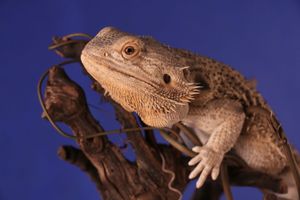
Central Bearded Dragon, Inland Bearded Dragon
Pogona vitticeps
Adult Size: up to 2 feet in length, hatchlings grow rapidly, reaching adult size between 12 an d 18 months of age.
Lifespan: 8-10 years on average
A fairly large Agamid lizard species, this popular pet reptile originates from Central Australia where it inhabits semiarid to arid woodlands and rocky deserts. These lizards utilize many behaviors in order to communicate with one another including head bobbing, bowing, and arm waving along with the ability to moderately change their coloration. Males are often slightly larger and can be distinguished from females due to the presence of hemipenile bulges, enlarged femoral pores, and often a more developed “beard”, which actually is a guttural throat pouch used for displays.
No longer imported from the wild, all captive animals available outside of Australia are captive bred. However, inbreeding has historically been a problem with selective breeding for certain color morphs.
A terrarium with a minimum floor size of 3’x2’ and height of 1.5’ is recommended for a single adult bearded dragon.
Bearded dragons do best on substrates not easily ingested, such as newspaper, paper towels, or cage carpet. Sand and mulch can be used, but the risk of accidental ingestion is forever present and can lead to life-threatening obstructions. Avoid gravel, calcium sands, and wood shavings.
Establish a temperature gradient within the enclosure with a warm end of 85-90 degrees F and a cool end no cooler than 70 degrees F. Provide a basking spot where it reaches 98-105 degrees F. Heating should be provided using heat lamps. Heat rocks should be avoided as they do not heat the enclosure adequately and can be a burn hazard for your pet.
Temperatures should always be monitored with a digital thermometer or infrared thermometer. Thermostats are also useful to ensure temperatures remain fairly constant within the enclosure.
Bearded dragons require UVB lighting to process calcium properly. UVB lighting should be provided using either fluorescent (tube or "spiral" bulbs) or mercury vapor bulbs designed specifically for use in reptiles. When selecting fluorescent bulbs the high-output 10.0 bulbs are recommended as tortoises require fairly high levels of UVB exposure. It should be noted that these bulbs will stop providing UVB long before they stop producing visible light so they will need to be changed regularly, usually every 6 to 12 months depending on the manufacturer's recommendations.
Bearded dragons are opportunistic omnivores and their diet should include both insects and vegetable matter. Due to a juvenile bearded dragon’s rapid growth rate, they should be fed 1-3 times daily with a mix of 50/50 insects and greens. Adults should be fed greens daily and fed approximately a tablespoon worth of vitamin and mineral-dusted insects 2-3 times a week. Prey items should not be larger than the space between the lizard's eyes.
Commonly accepted feeder insects include crickets, mealworms, super worms, black soldier fly larvae (a.k.a. calciworms or Phoenix worms), and feeder roaches. Greens should include collard and mustard greens, turnip greens, Italian chicory, and kale. Fruit or a variety of shredded vegetables can be offered in small amounts. Variety is important for balanced nutrition. Do not feed just one type of feeder insect and avoid a diet high in Dubia roaches as this may contribute to the development of gout.
Soak bearded dragons in shallow warm water for 15 minutes 2-3 times weekly to encourage drinking, urination, and defecation. Water should also be made available in the enclosure in a shallow bowl wide enough for the bearded dragon to climb into.
Provide multiple hide boxes throughout the enclosure as well as branches and ledges for basking.
Droppings should be removed as soon as possible. Disinfect the enclosure regularly using either Rescue brand disinfectant or a mixture of 1 tablespoon bleach to 1 cup of water, make sure to rinse thoroughly after. Bowls should be disinfected at least weekly.
Copyright © All Rights Reserved
